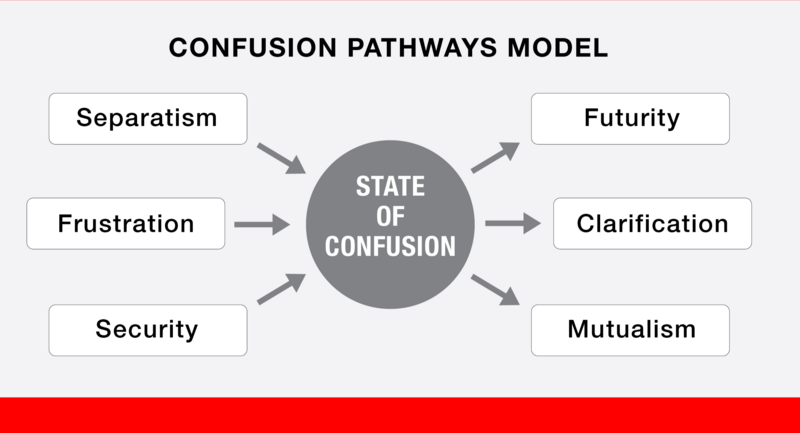ATD Blog
Thriving in a State of Confusion, Part 1
Thu Jun 25 2020

A state of confusion occurs most often when an unforeseen event forces us to work with people we “don't know, don't like, or don't trust.” The instinctive response is to withdraw from the situation to lessen the uncertainty. Yet, to respond proactively, leaders must force themselves and their followers to embrace a state of confusion.
Webster's Dictionary defines confusion as “The state of disarray; disorder; perplexity of the mind; or embarrassment.” Given that definition, you may wonder why anyone would intentionally create such a state. There is a good reason: When people are confused, they are open to redirection in the hope of reducing their discomfort. If the sources of their confusion can be examined and reframed in a mutually supportive setting, think of the potential benefits.
For such a radical idea to gain acceptance, a more constructive definition of confusion is needed. Looking again at the dictionary reveals that con means “to study or examine closely” and fusion means “merging of separate elements.” Thus redefined, a state of confusion now becomes a venue for learning together.
Confusion Pathways Model
The Confusion Pathways model is based upon multiple interviews with employees in dozens of organizations who acknowledged being confused when they were forced to undergo a change.
These findings provide the basis for the theory that there are three descriptive categories present in a state of confusion. Each one takes the form of a path that shows the way forward without disclosing what is at the end. Much like climbing a mountain trail, others have been this way before, so it must be safe to follow.
Picture in your mind three pathways that intersect to form a state of confusion where they cross. Each has two extremes at opposite ends of a continuum. As people travel along each pathway, they experience confusion at various points along the way. The challenge is to keep the team moving until the summit is reached and the purpose of the journey becomes clear to everyone.

Separatism—Mutualism
The differences between separatism and mutualism behaviors are subtle and difficult to spot; however, two critical factors stand out. First, the insecure co-workers move away from problem solving and pull away from teamwork. Second, doers move toward a problem and look to the team for support. This list provides a sampling of both types of behavior. When viewed together, the contrasts are more noticeable.
Separatism
Myopic self-interest and individual viewpoints dominate discussions.
Job descriptions and work assignments are disregarded.
Problems are ignored or passed along to someone else.
Mutualism
Enlightened joint perspectives and opinions are openly shared.
Self-directed co-workers establish team goals and set priorities.
Constant improvement is expected and realized quickly.
The contrasting behaviors listed above may at first appear to be a normal, natural part of everyday work life; however, if you expect people with differing work habits to join together when they are confused, it is not likely to happen without an intervention.
Frustration—Clarification
There is one observable characteristic that sets this pathway apart from the others. The doers will express their frustration and ask for clarification, making it easier to connect the two. Meanwhile, the insecure employees sit quietly nodding or shaking their heads in agreement or disapproval. By comparing this list, you can see some of these behaviors lurk just below the surface.
Frustration
Disappointment, disillusionment, and dissatisfaction are expressed openly.
Hindrances and blockages to completion of work abound.
Hidden agendas, contradictions, and mixed messages stifle creativity.
Clarification
Reflection, understanding, awareness, and discovery relieve tension.
Stated expectations and formally acknowledged objectives are declared.
Hopeful perspectives and a greater sense of connection resolve disputes.
With a little practice you will be able to dig out the frustrations of the disgruntled employees and get them working alongside the high performers. The behaviors listed above seem natural to both employee types. The challenge at this stage is to put a stop to the dysfunctional practices by reinforcing the functional ones.
Security—Futurity
Once this point is reached, it is likely that the insecure and confident employees are firmly entrenched at opposite ends of the security—futurity pathway. By now it has become risky and politically incorrect to speak openly about the existence of ambiguity and inconsistency.
Those with insecurity issues believe it to be unwise to share their concerns with anyone. They will keep to themselves and work silently to uphold the status quo. Their overall resistance to working in teams is likely to get stronger unless they are given no alternative.
By now the doers are embracing the future while the insecure employees are clinging to the past. Pulling both archetypes together in a state of confusion produces one immediate benefit: It forces everyone to concentrate on the same issues at the same time. Reviewing the list below helps to gain perspective on just how far apart these supposed teammates are from each other.
Security
Predictable environment with a firm future and no changes is sought after.
Job security with a promising outlook is the highest priority.
Steady workflow, higher pay, and regular promotions are all that matters.
Futurity
Being flexible, fluid, and fast moving motivates the doers to excel.
Doers are open to job changes, advanced technology, and new work methods.
Producers are confident that positions exist for those willing to move into the future.
Once the previously confused employees get comfortable sharing their stories and providing a rationale for their insecurity, the challenge will be to keep them from concentrating too much on justifying the past and not investing enough in talking about what to do differently in the future. It is healthy for followers to share their concerns and for leaders to hear what is behind their confusion. But be aware it could turn into a gripe session if not properly facilitated.
To be continued next week. . . .
